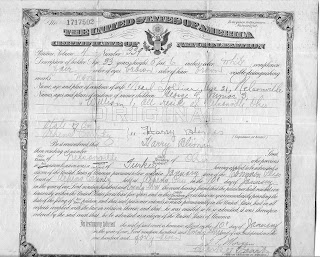This is an excellent Halloween article from ancestry.com written by
Juliana Smith
28 October 2011
Legend has it, on Halloween
the veil between this world and the next is lifted a bit. I for one am hoping
that when that happens tomorrow, a few of my ancestors will reveal
themselves. (Note to William Dennis—if you could reveal yourself through
the 1860 census, that would be awesome.)
So while I’m not a huge fan of “all
things gruesome,” I do feel somewhat of a connection with Halloween. I mean, as
family historians we’re all about dead people, right? We love cemeteries,
obituaries, death and burial records, and really anything death-related.
Ghost stories? Since our
favorite stories are about people who have passed on, I think they qualify. And
of course, if you’ve been doing family history for a while, you’ve probably
uncovered a skeleton or two in the closet. Sure you can still hand out candy to
the kiddies, but here are ways you can celebrate Halloween “family
history-style.”
Put Some Flesh on That Skeleton
Today we have online trees and software that make it easy to organize and keep track of names, dates, and places. They form a framework—or skeleton if you will—for our family history. But they’re not the story. The story lies in the details we find in the records.
Today we have online trees and software that make it easy to organize and keep track of names, dates, and places. They form a framework—or skeleton if you will—for our family history. But they’re not the story. The story lies in the details we find in the records.
What was your ancestor’s occupation
and what might that work have been like? Census records and directories are
good places to learn about their occupations. Take it a step further by
researching that occupation online, and in books and periodicals.
Were they active in their church?
Look into the history of your ancestor’s church. You may find him or her
mentioned in a published history of the religious community.
Were they educated, and could they
read and write? Most of us have seen the columns in censuses noting whether an
ancestor could read or write, or noting “at school” in the occupational field,
but have we ever put that together with their ages? Or how old they are when
you first find them listed as employed? In the 1880 U.S. Census, my
great-grandmother’s two sisters, aged fifteen and seventeen are employed as
coffee packers. Another column in that census revealed that when that
enumeration was taken in June, their father had been unemployed for three
months of that census year. It’s possible they had to leave school to help
supplement the family income.
Were there health issues that
impacted the family? By looking into the causes of death, both primary and
secondary, we can gain helpful insights into the family life. Often, the
attending physician had to note how long the deceased had been in his care.
This could indicate whether there was a lengthy illness or whether the death
was sudden and unexpected.
Locating Cemeteries and Other Haunts
Genealogists are ahead of the curve when it comes to appreciating cemeteries, but sometimes locating them is half the battle. If you can get your hands on a good local map for the vicinity in which you are searching, you may find some larger cemeteries outlined on the map. In other cases you might have to turn to local resources.
Genealogists are ahead of the curve when it comes to appreciating cemeteries, but sometimes locating them is half the battle. If you can get your hands on a good local map for the vicinity in which you are searching, you may find some larger cemeteries outlined on the map. In other cases you might have to turn to local resources.
Genealogical societies are a good
starting place. Like you, the genealogists in that group are likely cemetery
enthusiasts and probably know a lot about graveyards in the area—large and
small. They may have even canvassed the cemetery and published an index,
abstracts, or transcriptions from the headstones or other cemetery records.
Often a death certificate, obituary,
or some other death-related record will include the name of the cemetery where
your ancestor is buried. If not, map out the cemeteries that are near where the
individual lived.
For those searching in the U.S., the
U.S. Geological Survey’s Geographic
Names Information System (GNIS) is a very useful tool .
Select the state and county name and “cemetery” from the “Feature Class”
drop-down menu, you can see a list of cemeteries for a particular county.
From the list of results, you can
click on each cemetery name for more information and to map the location using
a number of mapping tools that will give you the exact location of the
cemetery.
You can also locate some of your
ancestors’ other “haunts” using this tool, including schools, churches, and
“populated places.” Maps show streams, rivers, ponds, wooded areas, mountains,
valleys, etc. If you have an obscure U.S. town or feature name associated with
your ancestor, this is a great place to look.
Communicating with the Dead
Superstitions say that Halloween is a good time to communicate with the deceased. Of course, I do that all the time. Usually the conversation is one-sided with a lot of pleading on my end and silence on their end, but occasionally, I could swear I hear laughing. (Of course, that could be my husband.)
Superstitions say that Halloween is a good time to communicate with the deceased. Of course, I do that all the time. Usually the conversation is one-sided with a lot of pleading on my end and silence on their end, but occasionally, I could swear I hear laughing. (Of course, that could be my husband.)


